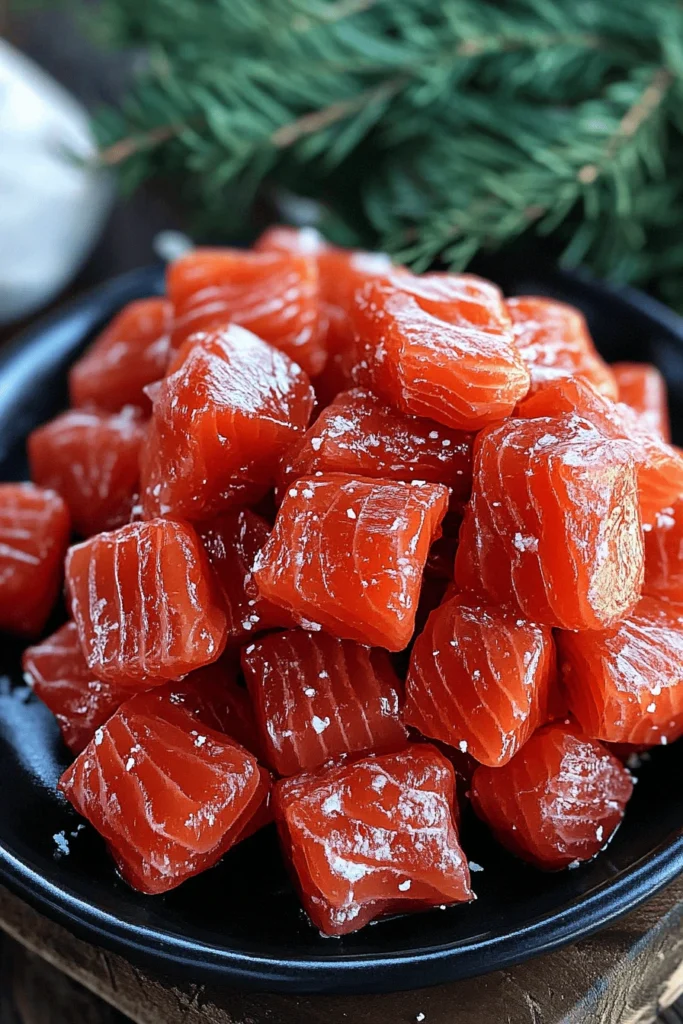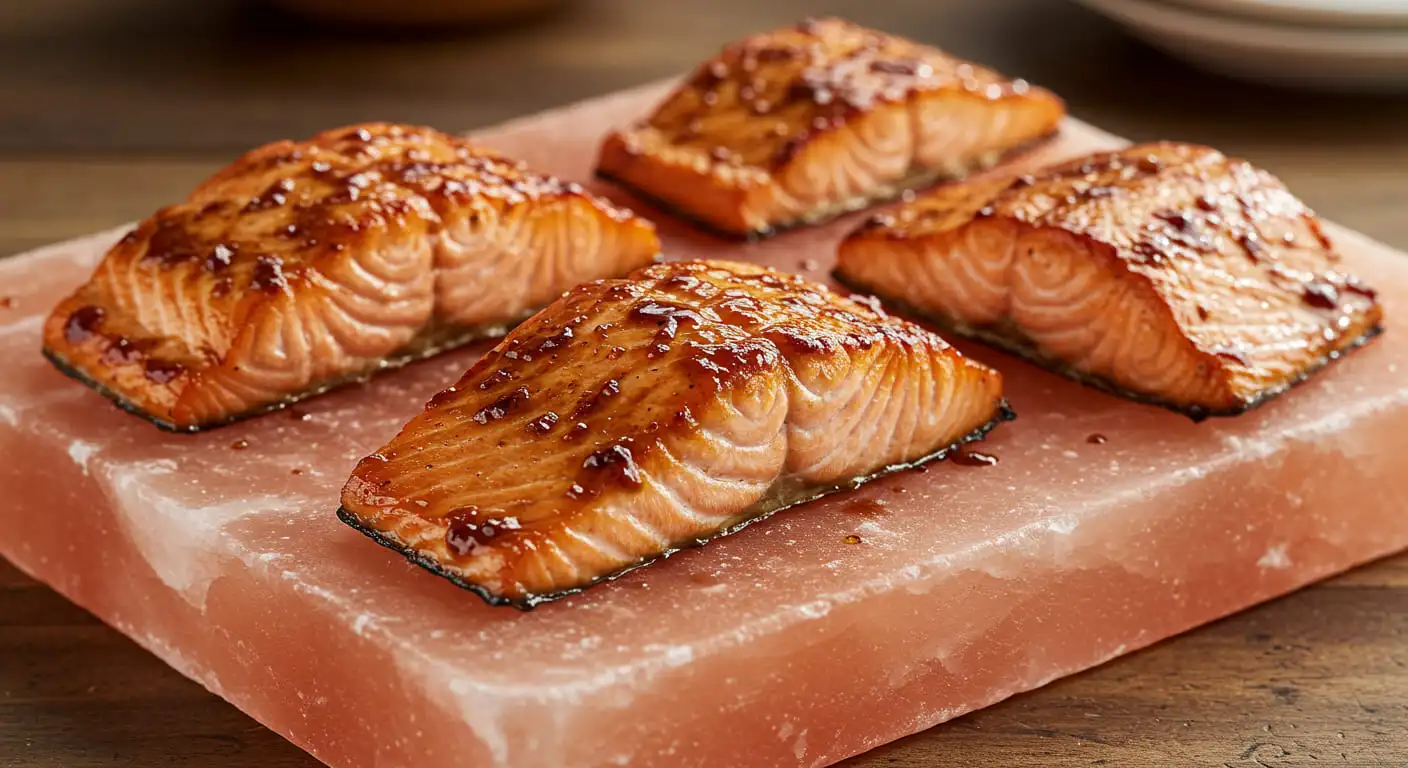I first tasted salmon candy on a camping trip in Alaska. The flavor was rich and sweet-savory. It changed how I see preserved fish forever. This Pacific Northwest treat is more than food; it connects us to traditional salmon preservation.
Salmon candy is not just a snack. It’s a form of art that turns wild-caught sockeye salmon into a masterpiece. This guide will help you make authentic salmon candy recipes or explore smoked salmon candy techniques.
Making salmon candy at home lets you control quality and try new flavors. It’s a protein-rich snack great for outdoor adventures or fancy appetizers. You can make fresh salmon into a tasty treat with a few ingredients and patience.
Prepare for a culinary adventure that mixes traditional smoking, precise temperature control, and sweet-savory flavors. Let’s start our journey to making homemade salmon candy!
Table of Contents
Understanding Traditional Salmon Candy: A Pacific Northwest Delicacy
Salmon candy is a special dish from the Pacific Northwest. It shows the rich food traditions of the area. Native American tribes created it to survive harsh winters.
Making salmon candy is more than just preserving food. It connects Native communities with their land. It turned survival into a food art form.
Origins and Cultural Significance
Salmon candy was key for Native Alaskan and Pacific Northwest tribes. They made it from fresh salmon to keep it for long periods.
- Primarily crafted from sockeye and Chinook salmon
- Preservation techniques dating back centuries
- Critical for sustaining communities during winter months
What Makes Salmon Candy Special
Salmon candy is special because of its taste and texture. It has a sweet-savory flavor and a chewy texture. This makes it a favorite in cooking today.
| Characteristic | Description |
|---|---|
| Flavor | Sweet and smoky with intense salmon essence |
| Texture | Firm, slightly chewy, similar to jerky |
| Nutritional Value | High protein, omega-3 fatty acids |
Historical Preservation Methods
Indigenous communities used special smoking and drying methods. They turned raw salmon into a preserved treat. This involved brining, air-drying, and smoking at low temperatures.
Today, salmon candy is a mix of culture, innovation, and old foodways in the Pacific Northwest.
Essential Ingredients and Equipment for Making Salmon Candy
Making salmon candy is all about the right ingredients and tools. These will turn your salmon into a tasty treat. Whether you’re buying from a store or making it at home, knowing what you need is key.
Key Ingredients for Salmon Candy
- Salmon Fillets: 2 lbs of fresh, high-quality salmon
- Salt: 1 tablespoon for flavor and preservation
- Sweeteners: 1/4 cup maple syrup or alternative options like honey
- Soy sauce: 1/2 cup for depth of flavor
- Black pepper: 1 teaspoon for additional seasoning
- Liquid smoke: 1 teaspoon for enhanced smoky taste
Choose fresh, wild-caught salmon for the best taste. A salmon candy store can offer top-quality fish and special ingredients to make your dish stand out.
Essential Equipment
- Smoker or dehydrator
- Drying racks
- Large brining container
- Sharp knife for precise cutting
- Cutting board
Your tools are important for making great salmon candy. Use your dehydrator at 165ºF to make a treat that will wow everyone.
Pro tip: Freeze your salmon first to kill parasites and keep it safe to eat. Cut it into 1/2 x 1-inch strips for even drying and the best texture.
Selecting the Perfect Salmon for Your Candy
Finding the right salmon is key to making tasty smoked salmon candy. The type of fish you choose can greatly affect the taste. So, it’s important to know what to look for, especially if you’re searching for salmon candy near me.
Wild-caught sockeye salmon is the best choice for candy. It has a great flavor and texture that makes your smoked salmon even better.
Best Salmon Species for Candy Making
- Wild Sockeye Salmon: Top recommendation for rich flavor
- Coho Salmon: Excellent alternative with a mild taste
- King (Chinook) Salmon: Premium option with high fat content
- Lake Trout: Suitable substitute for traditional salmon
Fresh vs. Frozen Salmon Considerations
Fresh salmon is the best, but high-quality frozen salmon works well too. Look for individually quick-frozen (IQF) options. They keep the texture and flavor just right.
Quality Indicators to Evaluate
| Quality Indicator | What to Look For |
|---|---|
| Color | Bright, vibrant pink or red without discoloration |
| Smell | Clean, ocean-like with no strong fishy odor |
| Texture | Firm, smooth flesh that springs back when touched |
| Origin | Wild-caught from reputable sources |
Pro tip: When shopping for salmon, ask your local fishmonger about the catch date and source. Local seafood markets often have the freshest options for your smoked salmon candy project.
Preparing Your Salmon for the Curing Process
Making delicious dried salmon or fish jerky begins with careful preparation. Your journey starts by picking the right cuts and preparing them just right. Experts say that the first steps are key to a great final product.
- Inspect the salmon fillets carefully for pin bones
- Remove pin bones using clean fishbone tweezers
- Cut salmon into uniform strips
- Aim for ½” thick strips without cutting through the skin
How you prepare your salmon affects the final texture of your fish jerky. Consistent strip sizes ensure even curing and smoking. Chefs suggest using 4-5 fresh or frozen salmon fillets for the best results.
| Preparation Step | Time Required | Key Considerations |
|---|---|---|
| Bone Removal | 15-20 minutes | Use clean, sharp tweezers |
| Strip Cutting | 10-15 minutes | Maintain ½” thickness |
| Initial Inspection | 5-10 minutes | Check for skin quality |
Proper salmon preparation turns regular fish into a tasty dried salmon treat. Paying close attention to detail at this stage is crucial for high-quality fish jerky.
The Art of Dry Brining Your Salmon
Turning your salmon into a tasty candied fish starts with dry brining. This step makes your salmon candy special, adding deep flavors and a unique texture. It’s what seafood fans love.
Dry brining is more than seasoning. It’s a detailed art that gets your salmon ready for smoking. You coat the fish with a mix of salt and sugar. This pulls out moisture and focuses the flavors.
Perfecting Your Salt and Sugar Ratio
For your salmon recipe, keep these ratio tips in mind:
- Use 3 cups of brown sugar for every 1 cup of kosher salt
- Make sure the dry brine is evenly spread
- Adjust the mix to taste
Curing Duration Essentials
The curing time depends on your salmon’s thickness:
- Thin fillets: 8-12 hours of curing
- Medium fillets: 12-18 hours of curing
- Thick fillets: 18-24 hours of curing
Temperature Control Techniques
Keeping the temperature steady during dry brining is key. Chill your salmon at 34-38°F. This stops bacteria growth and lets the salt and sugar work their magic.
| Fillet Thickness | Curing Time | Recommended Temperature |
|---|---|---|
| Thin | 8-12 hours | 36°F |
| Medium | 12-18 hours | 36-37°F |
| Thick | 18-24 hours | 37-38°F |
Pro tip: Always use a reliable refrigerator thermometer to ensure precise temperature control during your salmon preparation.
Creating the Perfect Pellicle Before Smoking
Making the perfect seafood snack starts with mastering pellicle formation. This step turns your salmon into a tasty treat. It creates a sticky surface that boosts smoke absorption and flavor.

First, brine your salmon. Then, dry it carefully for smoking. The pellicle is a thin, sticky layer on the fish’s surface. It’s key for smoke to penetrate.
- Rinse the brined salmon thoroughly with cold water
- Pat the fish dry using clean paper towels
- Allow the salmon to air dry for 2-3 hours
Environmental conditions affect pellicle formation. Place your salmon on a rack in a cool, well-ventilated area. The best temperature is between 50-60 degrees Fahrenheit. This helps create a sticky surface without risking bacterial growth.
| Pellicle Formation Parameters | Recommended Values |
|---|---|
| Drying Time | 2-3 hours |
| Temperature Range | 50-60°F |
| Humidity Level | Low to Moderate |
When your salmon has a slightly tacky, shiny surface, it’s time to smoke it. This pellicle ensures your traditional preparation method will result in a mouthwatering seafood snack with rich, deep smoky flavors.
Smoking Techniques for Salmon Candy
Making perfect smoked salmon needs precision and careful technique. Your journey starts with understanding the smoking process. This process turns ordinary fish into a delicious treat.
Mastering Temperature Control
Temperature control is key when making smoked salmon candy. Start by smoking at 150-160 degrees Fahrenheit for two hours. This low heat helps create rich flavors without overcooking the salmon.
- Initial smoking temperature: 150-160°F
- Duration of initial phase: 2 hours
- Final temperature: 200-210°F
- Target internal fish temperature: 160°F
Selecting the Perfect Smoking Wood
The wood you choose greatly affects the flavor of your smoked salmon. Wild-caught sockeye salmon goes well with mild woods like alder or maple. These woods enhance the fish’s natural taste without overpowering it.
- Best wood options: Alder, Maple
- Avoid: Hickory, Oak (too strong for salmon)
Timing and Doneness Indicators
Getting the perfect smoked salmon candy takes careful timing. After the first phase, increase the heat to 200-210°F for 1-2 more hours. Your goal is to reach an internal temperature of 160°F. This ensures the salmon is safe to eat and stays tender.
Pro tip: When shopping for smoked salmon candy for sale, look for similar smoking techniques that preserve the salmon’s delicate flavor and texture.
With practice, you’ll become a pro at making restaurant-quality smoked salmon in your kitchen.
Adding Sweet Glazes and Finishing Touches
Creating the perfect salmon is all about mastering glazing. Your salmon candy spoons and bites will turn into a gourmet treat with the right finishing touches.
The glaze is key for rich, complex flavors. Begin with a sweet base that matches the smoky salmon. Here are some top glaze options:
- Maple syrup (classic choice)
- Birch syrup (traditional Alaska style)
- Brown sugar reduction
- Honey blend
Timing and technique are important when applying your glaze. Brush the salmon every 40 minutes while smoking. This builds layers of sweetness and a beautiful finish.
| Glaze Ingredient | Quantity | Purpose |
|---|---|---|
| Maple Syrup | 2 tablespoons | Primary sweetener |
| Brown Sugar | 1 tablespoon | Depth of flavor |
| Minced Ginger | 1 teaspoon | Subtle heat |
Pro-tip for salmon candy spoons: Let your glaze cool a bit before brushing. This prevents burning. Aim for a glossy, caramelized exterior that seals in moisture and boosts the salmon’s natural richness.
Storage and Preservation Methods
Keeping your homemade seafood snack fresh is key. Your salmon can stay tasty and safe with the right storage. This way, you can enjoy it for months.
Packaging Techniques for Maximum Freshness
Vacuum sealing is the best way to keep salmon fresh. It keeps air out and stops bacteria from growing. This method makes your snack last longer.
- Use food-grade vacuum-seal bags
- Remove all excess air before sealing
- Label packages with preparation date
Storage Duration and Guidelines
How long your salmon stays fresh depends on how you store it. Knowing the right storage methods is important for keeping it good.
| Storage Method | Refrigerated | Frozen |
|---|---|---|
| Vacuum Sealed | Up to 10 days | Up to 6 months |
| Standard Container | 3-5 days | 2-3 months |
Signs of Spoilage to Watch For
It’s important to know when your salmon has spoiled. Look out for these signs:
- Unusual odor
- Visible mold
- Slimy texture
- Discoloration
By following these storage tips, you’ll get the most out of your homemade salmon. You’ll always have a safe, tasty seafood snack ready.
Conclusion
Making salmon candy at home is more than cooking. It connects you to the Pacific Northwest’s culinary traditions. By learning to make this treat, you’ve gained a skill passed down through generations.
Your homemade salmon is a mix of skill and heritage. Each piece, cured and smoked, is not just a snack. It’s a cultural recipe that has fed communities for years. The curing and smoking process turns ordinary fish into a nutritious delicacy.
Whether you share your salmon as an appetizer or keep it for yourself, you’re part of a special tradition. This tradition celebrates the Pacific Northwest’s bounty. Remember to store it in an airtight container to keep it fresh for up to a week.
Your salmon candy-making journey is just starting. Try different salmon types and spice blends. Most importantly, enjoy the process of creating a remarkable Pacific Northwest delicacy that connects you to a rich culinary heritage.
FAQ
What exactly is salmon candy?
Salmon candy is a sweet and savory treat from the Pacific Northwest. It’s made by curing and smoking salmon with a sweet glaze. This creates a unique flavor that’s both tasty and preserved.
What type of salmon works best for making salmon candy?
Sockeye salmon is the top choice for its rich taste and firm texture. But, you can also use king or coho salmon. Pick fresh, high-quality fish with a bright color and clean smell.
How long does it take to make salmon candy?
Making salmon recipe takes 2-3 days. You’ll need time for cleaning and cutting, dry brining, creating a pellicle, and smoking. The exact time depends on your recipe and the salmon’s thickness.
Can I make salmon candy at home if I don’t have a professional smoker?
Yes, you can make it at home. Use a regular smoker, grill with a smoking box, or even a home oven. Just make sure to keep the temperature low and smoke circulation good.
How long can salmon candy be stored?
Properly stored, salmon lasts up to 2 weeks in the fridge. Vacuum-seal or use an airtight container. For longer, freeze it for up to 3 months. Always check for spoilage before eating.
What makes salmon candy different from regular smoked salmon?
Salmon candy has a sweeter glaze and a drier texture. It’s cut into smaller pieces and tastes more intense than regular smoked salmon.
Is salmon candy a healthy snack?
Salmon candy is nutritious, packed with protein, omega-3s, and nutrients. But, it’s high in sodium and sugar. Enjoy it in moderation.
What traditional tools are used in making salmon candy?
Traditional tools include drying racks, smokers, and brining containers. Indigenous communities used smoke houses and natural drying methods.
Can I customize the flavor of my salmon candy?
Absolutely! Try different wood chips for smoking and various sweeteners and spice blends. Create your own unique flavor.
Where can I buy salmon candy if I don’t want to make it myself?
Find salmon candy at specialty seafood stores, farmers markets in the Pacific Northwest, online, and gourmet food shops. Local Alaskan and Pacific Northwest businesses often make it.

